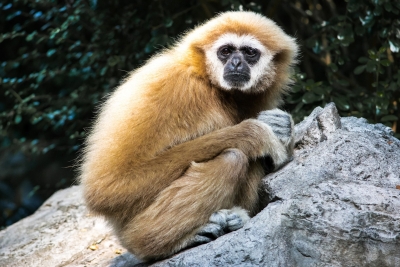
Gibbon, (family Hylobatidae), any of approximately 20 species of small apes found in the tropical forests of Southeast Asia. Gibbons, like the great apes (gorillas, orangutans, chimpanzees, and bonobos), have a humanlike build and no tail, but gibbons seem to lack higher cognitive abilities and self-awareness. They also differ from great apes in having longer arms, dense hair, and a throat sac used for amplifying sound. Gibbon voices are loud, are musical in tone, and carry over long distances. The most characteristic vocalization is the “great call,” usually a duet in which the female leads and the male joins in with less complex notes, used as a territorial marker by both sexes. The various species of gibbons can be divided into four genera: Hoolock, Hylobates, Nomascus, and Symphalangus. Molecular data indicate that the four groups are as different from one another as chimpanzees are from humans.
Gibbons are arboreal and move from branch to branch with speed and great agility by swinging from their arms (brachiating). On the ground, gibbons walk erect with the arms held aloft or behind. They are active during the day and live in small monogamous groups that defend territories in the treetops. They feed mainly on fruit, with varying proportions of leaves and with some insects and bird eggs as well as young birds. Single offspring are born after about seven months’ gestation and take seven years to mature.
Gibbons may be the most endangered groups of primates on Earth. Although they are still widely distributed in the rainforests and monsoon forests of Southeast Asia, they are increasingly under threat as their forest habitat is being destroyed. Nearly all gibbon species are considered endangered or critically endangered by the International Union for Conservation of Nature and Natural Resources; the eastern hoolock gibbon (H. leuconedys) of northern Myanmar is classified as a vulnerable species. Gibbons of all types are hunted for food and killed for their supposed medicinal properties.
Credit : Britannica
Picture Credit : Google




